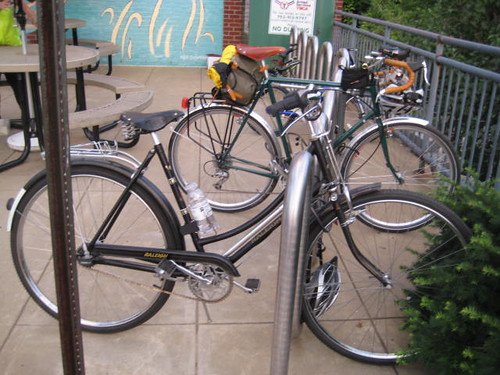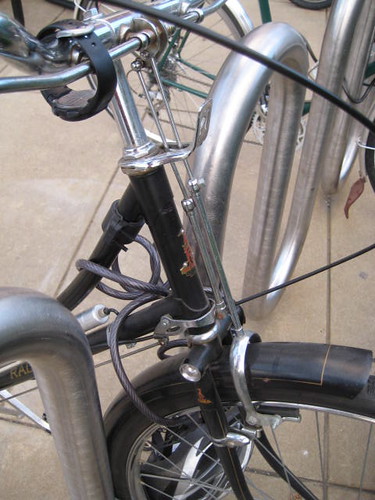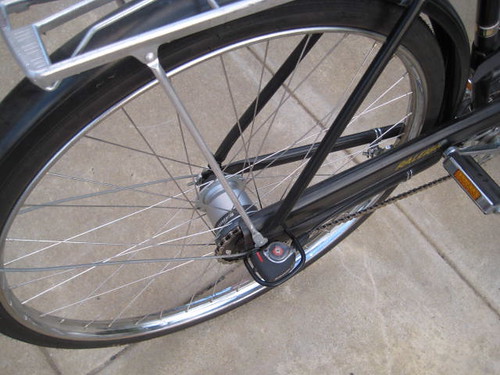I saw a fun bike at my local Whole Foods last night, and just had to take some pictures and write about it.

What you see there is a classic DL-1 "roadster" bicycle from Raleigh (with my bike in the background, of course). These were the standard "utility" bikes for a long, long time in Britain... the bikes ridden to work and around town by the working class... including the folks who made the bikes. Sturdy, simple, and reliable, these bikes were designed to get you where you needed to go, in all weather, day or night. This particular one is a "ladie's" frame, with the dropped top tube for skirt clearance. I couldn't ascertain the age of it, but I'm guessing sometime in the 70s, which I believe was the last they were imported to the US.

Unlike the similar and more familiar Sports model (technically a "light roadster" but once known in the US as "English racers"...a misnomer if there ever was one), the DL-1 and similar bikes used "rod brakes"... instead of cables, the brakes are actuated by solid rods attached to the levers, as you can see in the photo to the right. You'll also notice that the brake shoes actually rub on the inner surface of the rim, to either side of the spokes, rather than on the side walls of the rim, as most brakes do.

One thing that I noticed that sets this bike apart is that the drive train has been modified and modernized. Typically, a bike like this would have had the classic Sturmey-Archer AW three speed internally geared hub, a very reliable, durable hub. I've got a bike with one of those hubs that dates back to 1966, and it's still going strong, and two others that are from 1951, and should be perfectly fine after a disassembly, cleaning and lube. They're just that good. However, the gear range and number of options doens't really appeal to Americans these days, so this bike was updated with a seven speed SRAM Spectro S7 internally geared hub. More gears, slightly wider total range, and smoother steps between gears. I can understand why the change was made.... but the sentimental side of me wishes it still had the AW.

For a moment I wondered why the owner didn't also take the opportunity to upgrade the rims on the bike, while they were having the rear wheel rebuilt with the new hub. Then I remembered the brakes... you see, you need a rim designed for rod brakes if you're going to use rod brakes. So what's the deal with rod brakes? Well, cables stretch and can break, causing poor or no braking... the rods don't stretch, and it's hard to imagine a scenario in which they'd break. On the other hand, from what I've heard, none of the rod brakes offer stellar braking performance, so maybe it's not such a great thing. Then again, on a bike like this, you're not likely to be travelling at a high rate of speed, so perhaps it's less of an issue. I'll let you know when I finally get a chance to ride one!
 What you see there is a classic DL-1 "roadster" bicycle from Raleigh (with my bike in the background, of course). These were the standard "utility" bikes for a long, long time in Britain... the bikes ridden to work and around town by the working class... including the folks who made the bikes. Sturdy, simple, and reliable, these bikes were designed to get you where you needed to go, in all weather, day or night. This particular one is a "ladie's" frame, with the dropped top tube for skirt clearance. I couldn't ascertain the age of it, but I'm guessing sometime in the 70s, which I believe was the last they were imported to the US.
What you see there is a classic DL-1 "roadster" bicycle from Raleigh (with my bike in the background, of course). These were the standard "utility" bikes for a long, long time in Britain... the bikes ridden to work and around town by the working class... including the folks who made the bikes. Sturdy, simple, and reliable, these bikes were designed to get you where you needed to go, in all weather, day or night. This particular one is a "ladie's" frame, with the dropped top tube for skirt clearance. I couldn't ascertain the age of it, but I'm guessing sometime in the 70s, which I believe was the last they were imported to the US. Unlike the similar and more familiar Sports model (technically a "light roadster" but once known in the US as "English racers"...a misnomer if there ever was one), the DL-1 and similar bikes used "rod brakes"... instead of cables, the brakes are actuated by solid rods attached to the levers, as you can see in the photo to the right. You'll also notice that the brake shoes actually rub on the inner surface of the rim, to either side of the spokes, rather than on the side walls of the rim, as most brakes do.
Unlike the similar and more familiar Sports model (technically a "light roadster" but once known in the US as "English racers"...a misnomer if there ever was one), the DL-1 and similar bikes used "rod brakes"... instead of cables, the brakes are actuated by solid rods attached to the levers, as you can see in the photo to the right. You'll also notice that the brake shoes actually rub on the inner surface of the rim, to either side of the spokes, rather than on the side walls of the rim, as most brakes do. One thing that I noticed that sets this bike apart is that the drive train has been modified and modernized. Typically, a bike like this would have had the classic Sturmey-Archer AW three speed internally geared hub, a very reliable, durable hub. I've got a bike with one of those hubs that dates back to 1966, and it's still going strong, and two others that are from 1951, and should be perfectly fine after a disassembly, cleaning and lube. They're just that good. However, the gear range and number of options doens't really appeal to Americans these days, so this bike was updated with a seven speed SRAM Spectro S7 internally geared hub. More gears, slightly wider total range, and smoother steps between gears. I can understand why the change was made.... but the sentimental side of me wishes it still had the AW.
One thing that I noticed that sets this bike apart is that the drive train has been modified and modernized. Typically, a bike like this would have had the classic Sturmey-Archer AW three speed internally geared hub, a very reliable, durable hub. I've got a bike with one of those hubs that dates back to 1966, and it's still going strong, and two others that are from 1951, and should be perfectly fine after a disassembly, cleaning and lube. They're just that good. However, the gear range and number of options doens't really appeal to Americans these days, so this bike was updated with a seven speed SRAM Spectro S7 internally geared hub. More gears, slightly wider total range, and smoother steps between gears. I can understand why the change was made.... but the sentimental side of me wishes it still had the AW. For a moment I wondered why the owner didn't also take the opportunity to upgrade the rims on the bike, while they were having the rear wheel rebuilt with the new hub. Then I remembered the brakes... you see, you need a rim designed for rod brakes if you're going to use rod brakes. So what's the deal with rod brakes? Well, cables stretch and can break, causing poor or no braking... the rods don't stretch, and it's hard to imagine a scenario in which they'd break. On the other hand, from what I've heard, none of the rod brakes offer stellar braking performance, so maybe it's not such a great thing. Then again, on a bike like this, you're not likely to be travelling at a high rate of speed, so perhaps it's less of an issue. I'll let you know when I finally get a chance to ride one!
For a moment I wondered why the owner didn't also take the opportunity to upgrade the rims on the bike, while they were having the rear wheel rebuilt with the new hub. Then I remembered the brakes... you see, you need a rim designed for rod brakes if you're going to use rod brakes. So what's the deal with rod brakes? Well, cables stretch and can break, causing poor or no braking... the rods don't stretch, and it's hard to imagine a scenario in which they'd break. On the other hand, from what I've heard, none of the rod brakes offer stellar braking performance, so maybe it's not such a great thing. Then again, on a bike like this, you're not likely to be travelling at a high rate of speed, so perhaps it's less of an issue. I'll let you know when I finally get a chance to ride one!
3 comments:
This looks like one of the "new" traditional European style bikes that are getting so popular in New York, to be ridden to work in suit and tie. I sent you a New York Times article about them.
Do you think it's the same?
K
Well, this is an old bike, but it's one of the inspirations for the new ones that are becoming popular in some US cities.
I've got a men's version of the DL-1. Sturmey Archer AW hub with a 65 12 date code; I call the bike a 1966 model. The serial number on the bottom bracket is no help as far as identifying the date; it simply says "427"... an out-of-sequence number. I've heard of other examples of this.
I was lucky- I got it at a garage sale for almost nuthin'.
:D
Post a Comment